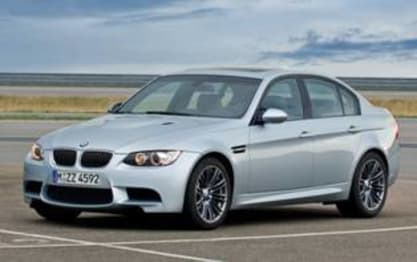BMW M3 sedan 2008 review
- BMW M Models
- BMW M3
- BMW M5
- BMW M Models 2008
- BMW M3 2008
- BMW M5 2008
- BMW M Models Reviews
- BMW M3 Reviews
- BMW M5 Reviews
- BMW Reviews
- BMW Coupe Range
- BMW Sedan Range
- Coupe
- Sedan
- BMW
- Prestige & Luxury Cars
- Sports cars
The road from the racetrack to the High Street is not so long.
Time was when the M5 was the pinnacle of four-seater performance for BMW.
Now, it seems, smaller sibling, the M3, is fast closing in a bid to take on the supercoupe mantle.
For the first time, the M3 has been fitted with a V8 engine - the power bulge in the bonnet, flanked by air intakes (one a dummy), is a dead giveaway.
Developing 309kW at 8300rpm, the new high-revving V8 features eight individually controlled throttle butterflies, normally found on race cars, for faster response and performance, as well as variable double-Vanos camshaft control. Peak torque of 400Nm comes up at 3900rpm thanks to, among other things, an engine management system that can process more than 200 million operations per second.
Weighing 15kg less than the six-cylinder motor in the model it replaces, the 4 litre V8 continues the BMW M tradition of high-revving - it can spin all the way to 8400rpm - while 85 per cent of the engine's pulling power is available up to 6500rpm.
Power, sent to the rear wheels through a six-speed manual gearbox, has the M3 able to hit 100km/h from rest in just 4.8 seconds, while returning a respectable fuel consumption of 12.4 litres per 100km (22 miles per gallon) on the combined urban/highway cycle.
What does the racetrack have to do with road cars? Plenty, according to the manufacturer.
The M3 eight-cylinder engine has a direct link to BMW's Formula One program, its racing pedigree going back to the start of the genesis of the marque's most recent involvement with a V10 engine in the BMW Williams F1 Team in 2000.
Testing and racing with this engine helped BMW engineers develop the 5 litre V10 which now powers the BMW M5 and M6.
However, this wasn't the first time BMW had been involved at the pinnacle of world motorsport. BMW was an engine partner to Brabham, which used four-cylinder 1.5 litre turbocharged units to win the F1 world championship in 1983 with Nelson Piquet behind the wheel.
With F1 regulations changing in 2006, V10 engines were being replaced by V8s, encouraging BMW engineers to replicate the development that resulted in the 5 litre V10.
Building the world's most advanced V8 for the new M3 was a natural progression.
Many of the design principles incorporated in the new eight-cylinder engine are identical to those used in the V10 - the two powerplants share nearly 80 per cent of their components - both blocks being cast at BMW's Landshut foundry, the same facility that turns out blocks for the BMW Sauber F1 team.
Both engines are engineered to extremely high tolerances, which mean they can operate safely and reliably at extremely high speeds. At full power, the pistons in an F1 car are moving at 25m a second, while those in the M3 engine are not far behind at 20m per second.
The difference is that the M engine must last for the life of the M3, while the F1 engine is rebuilt after just two races.
To cope with the colossal mechanical stresses, the M3 V8 is constructed from an array of special materials - the crankcase is made of lightweight aluminium silicon alloy with bores lined with hard silicon crystals, which allow the iron-coated pistons to run without cylinder liners. Weight saving less wear are the results.
The new M3 is the first production vehicle in its segment to feature a carbon-fibre roof, serving to reduce the weight of the car by 5kg and improve handling thanks to the lower centre of gravity. Compared to a conventional steel roof incorporating a sunroof, the advantage is 22kg.
If all this is not enough to get the juices flowing, drivers of the race-bred M3 can also tailor the car's behaviour and performance through MDrive on the steering wheel.
Steering forces can be varied between Normal and Sports settings, electronic damper control can be adjusted with three different settings, Normal, Comfort and Sports, and the dynamic stability control can be completely disengaged, all at the touch of a button.
Continuing the motorsport theme, for the first time, Australians can order their new M3 with Melbourne Red or Jerez Black paintwork, which like other M colours is named after famous F1 circuits around the world, including Interlagos Blue and Silverstone.
Considering the millions of dollars spent on Formula One, $157,000 to sample the BMW M3 Coupe does not seem so bad.
Related story
BMW M3 convertible: first drive
Pricing guides
Range and Specs
| Vehicle | Specs | Price* | |
|---|---|---|---|
| M6 | 5.0L, PULP, 7 SP SEQ AUTO | $38,060 – 44,770 | 2008 BMW M Models 2008 M6 Pricing and Specs |
| M6 | 5.0L, PULP, 7 SP SEQ | $35,090 – 41,800 | 2008 BMW M Models 2008 M6 Pricing and Specs |
| M5 | 5.0L, PULP, 7 SP SEQ | $28,710 – 34,540 | 2008 BMW M Models 2008 M5 Pricing and Specs |
| 550I Sport | 4.8L, PULP, 6 SP AUTO | $23,320 – 28,820 | 2008 BMW M Models 2008 550I Sport Pricing and Specs |
$47,999
Lowest price, based on 3 car listings in the last 6 months














